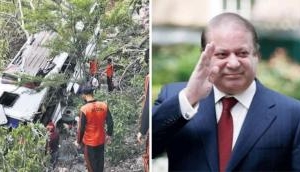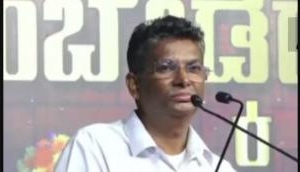
Cleaning up the Ganga was one of the most important promises Prime Minister Narendra Modi had made during the run-up to the 2014 elections. As the candidate from Varanasi, Modi claimed he was called to the city by Ganga Maiya herself.
High on symbolism, low on substance
Soon after he became prime minister, he took a number of symbolic steps to display his commitment towards the river. This included renaming the Union Water Resources Ministry as the Ministry of Water Resources, Ganga Rejuvenation and River Development.
The charge of the ministry was given to Uma Bharati, who has championed the Ganga's cause for many years.
The National Mission for Clean Ganga (NMCG) and National Ganga River Basin Authority (NGRBA) were placed under the newly renamed ministry.
On 7 July 2014, the NMCG organised a meeting - titled Ganga Manthan - on the issue. So far, two meetings of reformulated NGRBA have been called, one under the chairmanship of Modi and another presided over by Bharati.
Industries along the Ganga were instructed to set up online monitoring capabilities and ensure zero liquid discharge. Towns along the Ganga were told to submit an action plan in two months. Many foreign governments, including those of Japan, the US, Germany, Canada, France and Australia, among others, promised aid as well as technical and commercial tie-ups.
The report of the Ganga River Basin Management Plan, commissioned when Jairam Ramesh was the UPA's Environment Minister, has reportedly been submitted by the IIT Consortium, but we don't know what happened to it.
This, in short, is what the government can claim to have achieved in its mission to clean up the Ganga.
But the actual condition of the Ganga hasn't improved anywhere since the Modi government took over.
NDA hasn't learnt from history
It needs to be remembered that Modi is the second prime minister of independent India who has expressed concern about the state of the Ganga.
Interestingly, the first one was a Congress Prime Minister, Rajiv Gandhi, who launched the Ganga Action Plan three decades ago. In 1974, a decade before Rajiv became prime minister, Indira Gandhi's government created an institutional framework to contain water pollution.
The sordid state of the Ganga and other rivers is sufficient evidence that the country's water pollution governance and the GAP has achieved very little success.
Are the Modi government's efforts any different? Have any lessons been learnt from earlier failures? Has the Modi government provided any credible analysis as to what ails the Ganga and provided any credible road map to rejuvenate the river?
Unfortunately, the answer to each of these questions is a clear, big no.
How the government will actually end up harming the Ganga
Far from cleaning up the Ganga, there are at least five ideas of the NDA government that might just end up harming the river.
1) Nitin Gadkari's announcement that he plans to build a barrage at every 100 km along the Ganga in the 1,600-km stretch between Allahabad and Haldia. Ironically, he announced this at the Ganga Manthan.
2) The river-linking project.
3) PMO's push for more dams along the Ganga in Uttarakhand.
4) Finance Minister Arun Jaitley's budget announcement last year of a riverfront development plan along the Ganga. This is on the lines of the Sabarmati, which itself is a discredited effort.
5) The NDA's lack of emphasis on environmental norms and the setting up of TSR Subramanian committee to dilute environmental laws is possibly the biggest threat to Ganga and all rivers.
Even though the Modi government has declared Aviral (continuous) Nirmal (clean) Ganga its aim, it has not given any credible road map for rejuvenation of the Ganga.
As far as cleaning the river is concerned, the government has done nothing differently from past efforts that failed to make any favourable impact on the river.
Far from cleaning the Ganga, the Modi government has at least five ideas that might end up harming the river
Neither has the government taken up any review of why past efforts have failed. The general consensus seems to be that if sufficient amount of money, technology, infrastructure and lip service is put together, it will deliver a rejuvenated Ganga.
But that is exactly what has been going on for more than three decades, without any success.
Criticism from within
It is apt that BJP MP Hukum Singh, who heads the 21-member parliamentary standing committee on water resources, was himself critical of the government on this issue.
Singh's committee came down heavily on the government for having done little to arrest rising pollution levels in the Ganga and other water bodies in its report that was tabled in Parliament on 27 April 2015.
"So where has the first step to clean and rejuvenate the river been taken? As a first step, our parliamentary team decided to visit Rishikesh and Hardwar, which is really the head of the river. Can you imagine what we saw? Huge drains carrying untreated sewage being dumped into the river. The smell was so foul, we could not even stand there. Effluents from industry only serve to worsen the situation. All the engineers associated with this project can be seen to have built palatial bungalows for themselves, but the river remains as dirty as ever. The situation there (in Varanasi) is no better. The story is the same with only 30 per cent of sewage water flowing into the Ganga after treatment whereas nearly 70 per cent of sewage flowed directly." Singh said.
One positive step by the government was the affidavit from the Ministry of Environment and Forests submitted in the Supreme Court in December last year in the case of Uttarakhand's hydro-power projects.
In that affidavit, the ministry accepted that hydro-power projects in Uttarakhand are not only prone to disasters, they would also be of no help in rejuvenating the Ganga.
This govt has done nothing differently from past efforts that failed to make any favourable impact on the river
However, barely a month later, in January, the PMO directed the ministry to reverse its stand. The ministry obliged.
Another positive sign from the government could be seen in the report of the Union Water Resources Ministry assessing the environment flows required in India's rivers, including the Ganga.
But the government has so far shown no move to implement the recommendations of the report.
What's the way out?
1) Make the governance of rivers bottom up, with clearly defined norms of participation of the people whose lives and livelihoods depend on the river.
2) Conduct a credible review to understand what did not work for so long.
3) Make the functioning of all urban areas, pollution control boards and sewage treatment plants participatory, transparent and accountable.
4) Accept the need for environmental flows in all rivers at all times.
5) Review the hydro plans in Uttarakhand and across the Ganga basin before going ahead with any new projects.
6) Review the development effectiveness of the Farakka barrage.
7) Focus on smaller tributaries and after achieving success there, replicate it with bigger rivers.
We can learn from others' experience and techniques but we need to realise that every river is different, and that our situation is very different from most other countries.
For more details, see Delhi Declaration adopted at the first India Rivers Week in November 2014.
It seems the Modi government specialises in symbolism without substance. Even the Supreme Court of India came down heavily on the government on the Ganga issue, even calling them Kumbhakarna.
The apex court has said that at this rate, there won't be any improvement in the river even in 200 years and that the government only seems interested in keeping the issue alive for the next elections.
Unfortunately, the judiciary does not have a great track record in this regard either. The Ganga cleaning case has been going on in the Supreme Court for close to 30 years and the Yamuna Maily case has been going on since 1994. However, we see no improvement in either rivers. One possible sign of hope is the January 2015 directive of the National Green Tribunal, which gave a detailed plan of progressing from 'maily' to 'nirmal' Yamuna.
However, we need to wait and see if this will help the river in any way.
The views expressed here are personal and do not reflect those of the organisation.
First published: 23 May 2015, 16:20 IST






![BJP's Kapil Mishra recreates Shankar Mahadevan’s ‘Breathless’ song to highlight Delhi pollution [WATCH] BJP's Kapil Mishra recreates Shankar Mahadevan’s ‘Breathless’ song to highlight Delhi pollution [WATCH]](https://images.catchnews.com/upload/2022/11/03/kapil-mishra_240884_300x172.png)

![Anupam Kher shares pictures of his toned body on 67th birthday [MUST SEE] Anupam Kher shares pictures of his toned body on 67th birthday [MUST SEE]](https://images.catchnews.com/upload/2022/03/07/Anupam_kher_231145_300x172.jpg)






